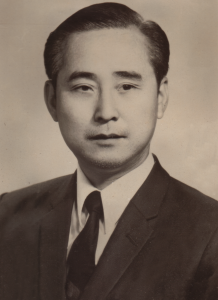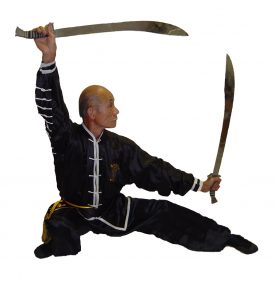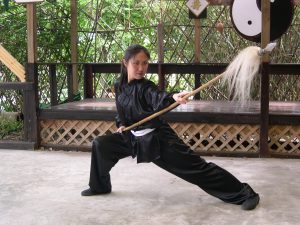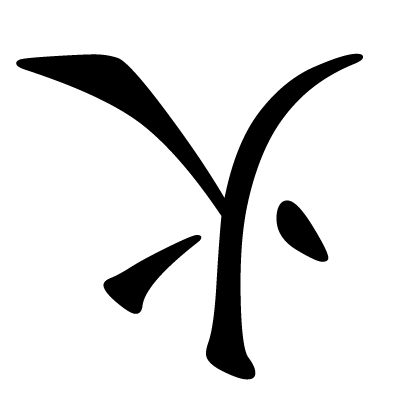The History of Wah Lum ®
The Wah Lum Tam Tui Northern Praying Mantis Kung Fu System has a deep-rooted history with an important lineage.
Grandmaster Lee Kwan Shan
In the early 1900’s an already accomplished martial artist by the name of Grandmaster Lee Kwan Shan entered the Wah Lum Monastery of Ping To district in Shantung province. There he committed himself to an arduous ten-year discipleship in the Praying Mantis system.
When Grandmaster Lee left the temple he traveled widely, eventually settling down at Shajing village in Canton province. It was here that he combined his Praying Mantis style with his own family system, the Tam Tui (seeking leg) style. Lee Kwan Shan’s style was noted for his long fist forms, spear and pole techniques, and whirling broadsword skills. Before his death in 1948, Lee accepted his youngest and last disciple, Pui Chan.
 Master Chan Wan Ching
Master Chan Wan Ching
Master Chan Wan Ching was Master Pui Chan’s older Kung Fu brother, who continued to teach him the Wah Lum System after Lee Kwan Shan died. He was the first president of the Hong Kong Wah Lum Kung Fu Association.
 Grandmaster Pui Chan
Grandmaster Pui Chan
Grandmaster Pui Chan (currently the Grandmaster of Wah Lum Kung Fu Association) studied with Lee Kwan Shan and then continued to learn and train with his older Kung Fu brother Chan Wan Ching making him the sixth generation master of Wah Lum. He is also a 33rd-generation disciple of the Shaolin Temple, and the first person to begin taking large tours to visit the Shaolin Temple.
In 1980, Grandmaster Chan built a Kung Fu Temple in Orlando, Florida. Calling it the Wah Lum Temple, he allows students from all over the country to live there and undertake intensive Kung Fu training in an atmosphere free of distractions. Grandmaster Chan has done this in order to preserve the traditional ways of Kung Fu training and to provide an atmosphere of serenity and sincerity in the modern world.
Grandmaster Chan has been featured in magazines and documentaries for his revered style and prowess in the martial arts industry. Some of his features include the Discovery Channel’s Secret of the Warrior’s Power, Living Legends of Kung Fu (Vol. I), Warrior Within – Inside the Martial Arts, and various interviews and articles with Kung Fu Magazine, Inside Kung Fu, and Journal of Chinese Martial Arts.
Grandmaster Chan has also received honors such as Instructor of the Year and Martial Artist of the Year from Inside Kung Fu Magazine and Black Belt Magazine. He is a 2003 inductee to the US Kuoshu Martial Arts Hall of Fame. Recognized and esteemed by many, Grandmaster Chan has been an integral part of contributing martial arts knowledge to the world. Through all his endeavors and accomplishments, most important to him are his love for his family, his pride in his students, and his whole-hearted practice of his system’s motto of integrating respect, kindness, fellowship, and strength in martial arts. You will always hear him say, “It’s not just a job, but a way of life.”
 Sifu Mimi Chan
Sifu Mimi Chan
Mimi Chan began her martial arts training under her father, Grandmaster Chan Pui, at the age of 3. By the age of 5, she was already performing in local exhibitions. At 17, she won her first of many Grand Championship titles. Now retired from competition, Mimi is currently undefeated.
At a young age, Mimi began performing on stage at various exhibitions around the world. She entered the movie world when she was chosen as the model and martial arts video reference for Disney’s animated feature, Mulan. She briefly worked in Hollywood doing stunt work and making small television appearances. In 2011, she decided to return to the film world and take on the endeavor of making a documentary about her father’s life. She found joy in doing work behind the camera and capturing the story of her father, a true artist and pioneer on film. She produced and directed her first documentary: Pui Chan: Kung Fu Pioneer. The film won 10 awards at film festivals around the country and screened throughout North America to sold-out audiences. Mimi is also the host of the Culture Chat Podcast.
A University of Central Florida Graduate, Mimi is currently the Chief Instructor at the Wah Lum Temple. She continues to strive to spread the spirit of martial arts and the Wah Lum System. She follows in the footsteps of her father by dedicating her life to teaching and training at the Wah Lum Kung Fu Temple.
Wah Lum® History
There are several published books authored by Grandmaster Pui Chan that expand on the history of the Wah Lum® System.
- Wah Lum Student Handbook
- Wah Lum Kung Fu First Form
- Wah Lum Tam Tui Northern Praying Mantis Kung fu 35th Anniversary Book
- Wah Lum Kung Fu Fatal Flute and Stick Forms
- Wah Lum Kung Fu Tornado Broadswords
- Wah Lum Kung Fu History and Philosophy
One of the characteristics that make Wah Lum® distinct is the combination of the Wah Lum Praying Mantis and Tam Tui styles. The lineage also pays homage to the village of Shajing where Grandmaster Chan and family members learned Wah Lum®.
One of the unique parts of Wah Lum history utilizes the Chinese character for fire (火) turned upside down to depict control and patience. This symbol is specific to the Chan Family members from the Shajing village and the Wah Lum® System.
